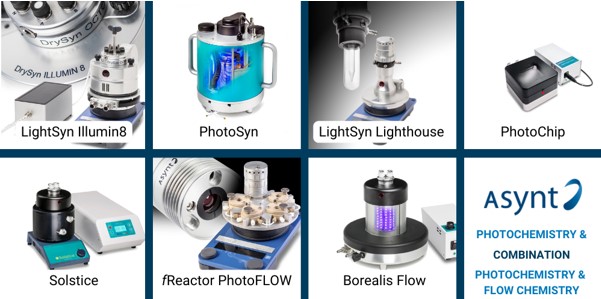Laboratory specialist, Asynt, announces a new unique and extensive range of photochemistry reactors as part of their broad catalogue of both batch and flow equipment which enable flexible use for chemists over a wide range of applications and scales.
Advancements in reactor technology in recent years has catalysed the rediscovery of ‘reagentless’ activation methods such as photochemistry, and the resulting new tools have changed the way researchers access photochemistry techniques and devise their synthetic routes and chemistries.
Asynt’s innovative photochemistry tools differ from others in several significant ways:
- Users can access multiple scales and applications using high quality apparatus from one trusted source. Reaction scales from mg’s to potentially multiple kg’s can be achieved across the range, with smaller batch photochemical reactors for the smaller quantities, to continuous flow photochemistry reactors equipped with high-power light sources for increased throughputs.
- Asynt utilise LED technology across the complete range of photoreactors for safe, efficient and controlled reactions at reliable and repeatable strengths.
- These photochemical reactors are designed to provide narrow emission bands and limit the power degradation between source and reagent with efficient light transfer methods using a variety of novel means, including unique innovations such as the LightSyn Lighthouse Quartz Reactor Rod.
- While traditional batch reactors are available in a vast range of volumes, their reaction volume is fixed. Combined photochemistry and flow chemistry reactors from Asynt enable a continuous process, effectively removing the dependence of reactor volume to deliver a continuous feed of products.
Asynt’s photochemistry reactor range provides easy to use, small footprint options with a complete range of wavelengths to enable selective reactions conditions. Single wavelength LEDs from 365 nm to 940 nm and even cool white IR (depending on the reactor) allow chemists access to practically all modern photochemistry methodologies. All the reactors are fully light sealed and interlocked for safety, and precise temperature control of both the LED light source and the reactor is available.
- Batch: LightSyn Lighthouse – 10 W LED in single position assembly or up to three positions on one hotplate. Built-in interlock for safety and ability to run under inert conditions.
- Parallel batch: LightSyn Illumin8 – up to 8 positions in parallel on one hotplate. Utilises DrySyn OCTO technology for sampling and inert atmospheres in each cell. Solstice & Solstice MAXI – higher power light source available in both 120 W and 180 W. Accommodates up to 12 x 8 mL vials or 12 x 20 mL vials respectively. Optimal cooling via circulated water source or temperature controlled circulatory system.
- Flow Photochemistry: fReactor PhotoFLOW – utilises 5-position continuously stirred tank reactors (CSTRs) in cascade, with independent photoreactor modules which deliver 10 W power per CSTR. Photochip LED Photoreactor – for use with GSM reactor blocks, it can accommodate 1 x large format and 2 x compact GSMs with total volumes of between 0.27 – 20.0 mL and Tube-in-Plate volumes of 7 mL.Borealis Flow – 15 mL FEP tube reactor available in a range of fixed wavelengths that convert the Uniqsis Cold Coil standalone coil reactor module into a flow reactor for photochemical applications. PhotoSyn – High-power LED photoreactor for continuous flow applications. Supplied with a high output programmable power supply (up to 700 W) that has USB, serial (RS232) and ethernet (TCP/IP) connectively. Wavelength modules available as both single and mixed wavelength.

Asynt is unique in supplying both batch and flow photochemistry equipment to chemists over the widest range of scales all from just one company. With highly efficient and safe solutions for both standalone photochemical reactions and combination flow and photochemical reactions, the question to chemists now, is can your ground-state chemistry give you access to cleaner, greener, ‘reagentless’ chemistry, and how do you best utilise these tools?
To discover more about the Asynt range of photochemistry solutions, please visit https://www.asynt.com/products/photochemistry/ or email enquiries@asynt.com







